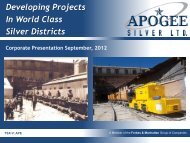Pulacayo Project Feasibility Study - Apogee Silver
Pulacayo Project Feasibility Study - Apogee Silver
Pulacayo Project Feasibility Study - Apogee Silver
Create successful ePaper yourself
Turn your PDF publications into a flip-book with our unique Google optimized e-Paper software.
<strong>Pulacayo</strong> 1 000 t/d Phase I <strong>Feasibility</strong> <strong>Study</strong> - NI 43-101 Technical Report<br />
090644-3-0000-20-IFI-100<br />
boreholes, it was found that 8 boreholes did not intersect or plot close to the proposed<br />
stopes. These boreholes were excluded from the database and were not used in the design<br />
of the underground workings.<br />
Two rock mass rating systems were used, namely Laubscher’s Mining Rock Mass (RMRL)<br />
System (1990) and Barton’s Q System (1974). The ore body and country rock were found to<br />
be generally in the poor to fair range of rock mass quality. The average RMRL values were<br />
estimated to be 44 (fair) for the hangingwall and 42 (fair) for the footwall. The average Q<br />
values were estimated to be 2.3 (poor) and 1.8 (poor) for the hangingwall and footwall,<br />
respectively. The results of the mapping exercise that was completed in one of the tunnels<br />
(drift OB7) show similar rockmass conditions in the country rock. The Q values average 2.6<br />
(poor) with a minimum of 1.3 (poor) and a maximum of 4.2 (fair). These values translate to<br />
equivalent RMR values of minimum of 47 (fair), average of 53 (fair) and maximum of 57 (fair).<br />
An effort was made to demarcate the different sections of the mine into different geotechnical<br />
zones based on rock mass characterization. This would have enabled design of different<br />
stope dimensions for the different geotechnical zones based on rock mass quality. This<br />
analysis was not conclusive due the limited number of boreholes in some of these areas. It is<br />
therefore recommended that additional geotechnical logging of boreholes that intersect the<br />
proposed stopes should be carried out to increase the database of rock mass quality. For<br />
design purposes, a single geotechnical zone was assumed.<br />
16.5.2 Mining Spans<br />
Analysis of the geotechnical data described above indicate that the recommended stope<br />
dimensions of maximum 30 m (height) by maximum 10 m (length) and maximum 6 m (width)<br />
will be stable. Stopes are expected to remain free standing for a reasonable time with<br />
possible sidewall slabbing issues for stopes that plot in the transition zone on Potvin’s<br />
Stability Graph. The slabbing material will generally come from the mineralized zones thus<br />
the dilution of ore should be minimized, as the diluting material will have some grade in it.<br />
Cemented backfill placed after the broken ore has been drawn out will provide permanent<br />
support to the stope back.<br />
16.5.3 Support of Excavations<br />
16.5.3.1 Pillars<br />
A sill pillar will be required below zero level to protect the San Leon tunnel from the proposed<br />
underground workings and a crown pillar will be required to protect the underground workings<br />
from the planned future open pit mine. The study proposes a crown/sill pillar thickness of<br />
15 m. This was determined based on a Safety Factor of 1.8 and an average Q value of 2.6.<br />
The possibility of having voids in the pillars was also taken into consideration. The design<br />
and stability of the proposed pillar width was assessed using empirical formulae and deemed<br />
sufficient.<br />
Crosscut protection pillars will also be required to support crosscuts during mining. Once all<br />
the stopes being serviced by the crosscut have been mined out, the crosscut pillar will be<br />
recovered on retreat. A 15 m wide crosscut protection pillar is deemed sufficient. This<br />
dimension was checked using numerical modeling code Map3D.<br />
TWP Sudamérica S.A. Av. Encalada 1257 Of. 801, Santiago de Surco Lima 33, Perú (51-1) 4377473<br />
Page 153



